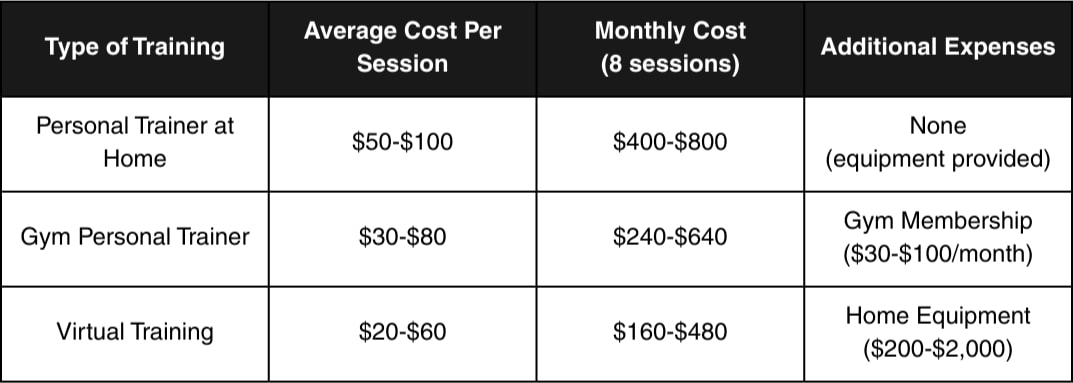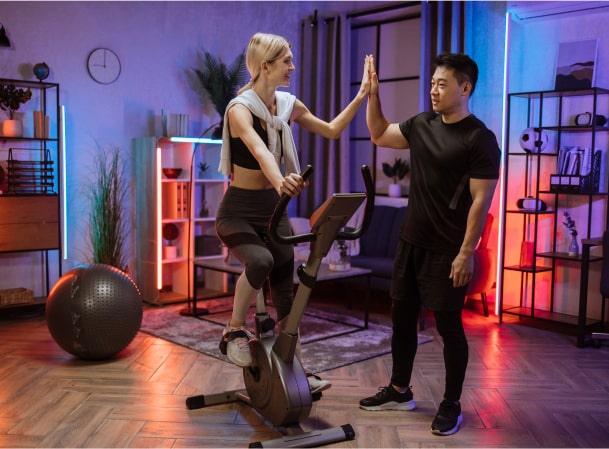In today’s fast-paced world, finding time to hit the gym can feel like an impossible task, as discussed in this article. Between work commitments, family responsibilities, and the ever-elusive work-life balance, many fitness enthusiasts are turning to a convenient alternative: the at-home personal trainer. But is bringing the gym to your living room worth it?
Let’s dive into the world of in-home personal trainers and explore whether this growing trend delivers on its promises.
The Rise of At-Home Fitness Services
The personal training industry has seen remarkable growth in recent years, with revenue increasing from $8.5 billion in 2012 to a projected $12.9 billion in 2025—a staggering 50% increase driven by customer satisfaction. This growth isn’t just happening in traditional gym settings. The home personal training market is expanding rapidly, driven by shifting consumer preferences and technological advancements.
According to recent industry data, the demand for personal trainers from home has surged by nearly 35% since 2023. This shift reflects a broader trend toward personalized, convenient fitness solutions that fit seamlessly into busy lifestyles.
What Exactly Is an At-Home Personal Trainer?
A home personal trainer is a fitness professional who travels to clients’ homes, bringing equipment, expertise, and personalized training sessions directly to your doorstep. Unlike virtual trainers who connect with clients through screens, these mobile trainers provide hands-on guidance and real-time adjustments to ensure proper form and maximize results.
Most personal trainers at home offer a range of services, from strength training and cardio to specialized programs like yoga or rehabilitation exercises. The key difference? Everything happens in the comfort of your own home.
Cost Comparison: At-Home vs. Gym-Based Training
One of the most common questions about in-home personal trainers concerns their job and cost. Let’s break down the numbers:

As you can see, while personal trainer home visits may have a higher hourly rate (averaging around $50-$100 per session), they eliminate the need for gym memberships and often provide necessary equipment. When factoring in these additional costs, the price difference becomes less significant.
It’s worth noting that many personal trainers offer home package deals that can significantly reduce the per-session cost for clients who commit to consistent training schedules.
Undeniable Benefits of In-Home Personal Training
1. Unmatched Convenience
The most obvious advantage of hiring a home personal trainer is convenience. No more commuting to the gym, waiting for equipment, or planning your day around peak gym hours. Your trainer comes to you at a time that fits your schedule, whether that’s early morning before work or late evening after the kids are in bed.
As one client put it: “Having my personal trainer from home allows me to fit in workouts during my lunch break without leaving my house. It’s been a game-changer for my fitness routine.”
2. Personalized Environment
When your personal trainer designs workouts specifically for your space and equipment, you get a truly customized experience. They’ll create exercises that work with your available area, whether that’s a dedicated home gym or just a small corner of your living room.
3. Privacy and Comfort
For many people, especially beginners, the gym can be an intimidating place. Working with an in-home personal trainer eliminates the anxiety of exercising in public. There’s no need to worry about judgment or comparison—it’s just you and your trainer focusing on your goals.
4. Consistent Accountability
When your home personal trainer comes to your door, there’s no escape. This built-in accountability ensures you’ll consistently show up for your sessions, which is crucial for achieving results. The convenience factor also means fewer cancellations due to traffic, weather, or other familiar excuses.
5. Family Integration
Many personal trainers from home can incorporate family members into sessions or design workouts that allow parents to exercise while still supervising children. This integration makes fitness a family affair rather than something that takes you away from loved ones.
Potential Drawbacks to Consider
While the benefits are compelling, hiring an at-home personal trainer isn’t without potential downsides:
1. Higher Cost Per Session
As mentioned earlier, the hourly rate for in-home personal trainers is typically higher than that of gym-based trainers, with the national average sitting around $50 per session, but ranging up to $80 or more, depending on location and experience. However, when considering the eliminated gym membership and convenience factor, many clients find the premium worthwhile.
2. Equipment Limitations
Despite many personal trainers bringing home equipment, you won’t have access to the full range of machines available at a commercial gym. However, experienced trainers are adept at creating challenging workouts with minimal equipment.
3. Space Constraints
Not everyone has a dedicated area for workouts. Your personal trainer at home will need to get creative if you’re working with limited space, which might restrict certain exercise options.
4. Fewer Social Opportunities
The gym provides a community atmosphere that home workouts lack. If you’re motivated by group energy or enjoy the social aspect of fitness, an in-home personal trainer might not fully satisfy this need.
Who Benefits Most from Home Personal Training?
While anyone can benefit from working with a home personal trainer, certain groups find this option particularly valuable:
- Busy professionals with limited time for gym commutes
- Parents of young children who can’t easily leave home
- Individuals with privacy concerns or gym anxiety
- People recovering from injuries who need specialized attention Older adults who prefer the safety and comfort of home
- Couples or families who want to train together
How to Choose the Right In-Home Personal Trainer
The perfect personal trainer from home requires careful consideration. Here are the y factors to evaluate:
1. Credentials and Experience
Always verify that your knowledgeable in-home personal trainer holds legitimate certifications from respected organizations like NASM, ACE, ACSM, or NSCA. Additionally, look for specific experience in your areas of interest, whether that’s weight loss, strength training, or rehabilitation.
2. Equipment and Specialization
Different personal trainers at home offer varying equipment options. Some bring everything needed, while others may require you to have basics like dumbbells or resistance bands. Clarify what they provide and what you’ll need to supply.
3. Insurance and Background Checks
Safety comes first. Ensure your home's personal trainer carries professional liability insurance and has undergone a thorough background check, especially since they’ll be entering your home.
4. Personality and Teaching Style
Perhaps the most crucial factor is finding someone whose personality and teaching approach align with your preferences. The right personal trainer at home should motivate you effectively without making sessions unpleasant.
The Technology Revolution in At-Home Training
Technology has significantly enhanced the at-home personal trainer experience. Modern trainers often integrate wearable fitness trackers, specialized apps, and digital platforms to track progress and to improve accountability between sessions.
Looking ahead to 2025, industry experts predict even greater integration of AI-driven personalization in in-home personal training. According to recent forecasts, trainers will increasingly use AI tools to gain deeper insights into client preferences, workout performance, and injury risk.
FitBudd: Revolutionizing the At-Home Training Experience
For both trainers and clients in the home personal trainer space, technology platforms like FitBudd are changing the game. This powerful tool allows personal trainers from home to streamline their businesses while providing clients with an enhanced training experience.
FitBudd’s comprehensive platform enables trainers to:
- Create customized workout plans for each client
- Track progress and metrics over time
- Manage scheduling and payments efficiently
- Provide nutritional guidance and meal plans
- Maintain communication between in-person sessions
For clients working with home personal trainers, FitBudd offers a seamless way to stay connected with their trainer, track workouts, and maintain motivation between sessions. The platform bridges the gap between in-person training and digital support, creating a hybrid model that maximizes results.
Cost-Effective Alternatives and Hybrid Approaches
If the whole in-home personal trainer experience exceeds your budget, consider these services as alternatives:
1. Semi-Private Sessions
Some personal trainers offer small group sessions for friends, couples, or family members, reducing the per-person cost while maintaining the convenience of home-based workouts.
2. Hybrid Models
Many clients find success with a combination approach: meeting with their home personal trainer once or twice monthly for form checks and program updates, then following prescribed workouts independently between sessions.
3. Virtual Check-ins
Some in-home personal trainers offer lower-cost virtual follow-ups between in-person sessions, providing accountability without the full expense of additional home visits.
The Future of At-Home Personal Training
The at-home personal trainer industry continues to evolve rapidly. By 2025, experts predict several key trends will reshape the landscape:
- Virtual and hybrid training models will continue to grow, with trainers offering both in-person home visits and virtual support.
- Wearable technology integration will become standard, with trainers utilizing client data to create more personalized programs that focus on recovery, mental health, and physical performance.
- Holistic wellness approaches will expand beyond physical fitness to incorporate nutrition, mental health, and recovery services.
- Subscription-based models are expected to gain popularity, offering clients flexible access to trainers across various platforms.
Is an At-Home Personal Trainer Right for You?
After weighing the benefits, challenges, and costs, the decision to hire a personal trainer at home comes down to your specific circumstances and priorities. Consider these questions:
- How much do you value convenience in your fitness routine?
- Does your schedule make it challenging to attend the gym consistently?
- Are you comfortable exercising in public environments?
- What’s your budget for fitness services?
- Do you have space at home for workouts?
- Do you prefer highly personalized attention?
If convenience, personalization, and consistency are top priorities—and if your budget allows—an in-home personal trainer could be the perfect solution for achieving your fitness goals.
Making the Most of Your At-Home Training Investment
If you decide to hire a home personal trainer, these tips will help maximize your investment:
- Communicate clearly about your goals, preferences, and limitations
- Create a dedicated space, even if small, for your workouts
- Stick to a consistent schedule to build momentum
- Use technology like FitBudd to track progress between sessions
- Be prepared for each session to avoid wasting valuable time
- Provide feedback regularly to refine your experience
- Commit to homework assignments between trainer visits
The Value Proposition of At-Home Personal Training
So, is bringing the gym to you worth it? For many people, the answer is a resounding yes. The at-home personal trainer model eliminates common barriers to fitness success while providing expert guidance tailored to your unique needs and environment.
Though the per-session investment may be higher than traditional gym training, the convenience, accountability, privacy, and personalization can provide a sense of pride in achieving personal fitness goals.
As one client put it: My personal trainer from home isn’t just saving me time—they’re making fitness possible in a life where it otherwise wouldn’t fit.”
Whether you’re a fitness newcomer intimidated by gym environments, a busy professional with limited time, or someone who simply prefers the comfort of your own space, exploring the world of in-home personal trainers might just be the fitness solution you’ve been searching for.
Ready to experience the benefits of personal training at home? Consider exploring platforms like FitBudd to connect with qualified professionals in your area who can bring expert guidance directly to your doorstep.
Frequently Asked Questions
1. How much does an at-home personal trainer typically cost?
The national average cost for an at-home personal trainer is around $50 per session, but prices can range from $30 to $80,+ depending on location, trainer experience, and specialization. Many trainers offer package discounts for clients who book multiple sessions.
2. Do I need special equipment for in-home personal training?
Most personal trainers who come to your home bring basic equipment, such as resistance bands, lightweight dumbbells, and exercise mats. For more specialized training, discuss equipment needs during your initial consultation—some trainers bring everything required, while others may recommend items for you to purchase.
3. How much space do I need for effective at-home workouts?
While more space offers greater exercise variety, an experienced in-home personal trainer can design effective workouts for almost any area. A space roughly 6’ x 6’ is typically sufficient for most training styles, though some exercises may require slight modifications in smaller areas.
4. How often should I schedule sessions with my home personal trainer?
For optimal results, most fitness professionals recommend 2-3 sessions per week with an at-home personal trainer. However, your specific frequency will depend on your goals, budget, and availability. Some clients see progress with just one weekly session combined with independent workouts.
5. Is at-home personal training safe during health concerns like COVID-19?
In-home personal training can be conducted safely with appropriate precautions. Many trainers now offer health screening, maintain social distancing when possible, sanitize equipment, and wear masks upon request. Discuss specific safety protocols with potential trainers before beginning.
6. Can I share my at-home personal training sessions with family members?
Many personal trainers who visit homes offer partner or small group options, allowing you to share costs with family members or friends. However, keep in mind that dividing attention between multiple clients may result in a lower level of personalization compared to one-on-one training.
7. How do I verify the credentials of an at-home personal trainer?
Always ask potential in-home personal trainers for proof of certification from recognized organizations (e.g., NASM, ACE, ACSM), liability insurance documentation, and references from current or former clients. You can also verify certifications directly with the issuing organizations in most cases.
8. What if I travel frequently? Can I still benefit from home personal training?
Yes! Many personal trainers who visit homes now offer hybrid models and branches , combining in-person sessions at home with virtual training during travel periods. Platforms like FitBudd make this transition seamless, allowing you to maintain consistency regardless of location.
92% trainers worldwide gave us 5 stars
Talk to your dedicated success manager and launch your branded fitness app during the demo in minutes.
Start your paid subscription for $79 FREE





%20to%20Become%20a%20Certified%20Personal%20Trainer-min.jpg)





